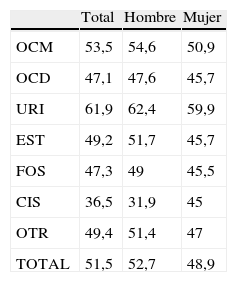evaluar un nuevo enfoque en el análisis de la litiasis urinaria en función de la combinación de sus componentes.
Material y métodosse analizaron un total de 7.949 litiasis y sus componentes principales y combinaciones, y se clasificaron en función del sexo y la edad. El análisis estadístico fue mediante el test de ji cuadrado.
Resultadosoxalato cálcico monohidrato (OCM) fue el componente más frecuente en hombres (39%) y mujeres (37,4%), seguido de oxalato cálcico dihidrato (OCD) (28%) y ácido úrico (URI) (14,6%) en hombres y de fosfato (FOS) (22,2%) y OCD (19,6%) en mujeres (p=0,0001). En la gente joven OCD y FOS fueron los componentes más frecuentes en hombres y mujeres, respectivamente (p=0,0001). En los pacientes mayores OCM y URI (por este orden) fueron los componentes más frecuentes en ambos sexos (p=0,0001). OCM es oxalatodependiente y está relacionado con las dietas de alto contenido en oxalato y baja ingesta de agua. El aumento progresivo de URI con la edad se relaciona principalmente con el sobrepeso y el síndrome metabólico. Respecto a la combinación de componentes, las más frecuentes fueron OCM (26,3%), OCD+Apatita (APA) (15,5%), URI (10%) y OCM+OCD (7,5%) (p=0,0001).
Conclusioneseste estudio presenta no sólo la composición de las litiasis, sino también las principales combinaciones de componentes en función de la edad y el sexo. Los resultados muestran que la composición de la litiasis está relacionada con los cambios en los hábitos dietéticos y de estilo de vida que ocurren durante la vida, y la estructura morfológica de las litiasis es indicativa de los mecanismos etiopatogénicos.
To evaluate a new approach to urinary stone analysis according to the combination of the components.
Materials and methodsA total of 7949 stones were analysed and their main components and combinations of components were classified according to gender and age. Statistical analysis was performed using the chi-square test.
ResultsCalcium oxalate monohydrate (COM) was the most frequent component in both males (39%) and females (37.4%), followed by calcium oxalate dihydrate (COD) (28%) and uric acid (URI) (14.6%) in males and by phosphate (PHO) (22.2%) and COD (19.6%) in females (p=0.0001). In young people, COD and PHO were the most frequent components in males and females respectively (p=0.0001). In older patients, COM and URI (in that order) were the most frequent components in both genders (p=0.0001). COM is oxalate dependent and is related to diets with a high oxalate content and low water intake. The progressive increase in URI with age is related mainly to overweight and metabolic syndrome. Regarding the combinations of components, the most frequent were COM (26.3%), COD+Apatite (APA) (15.5%), URI (10%) and COM+COD (7.5%) (p=0.0001).
ConclusionsThis study reports not only the composition of stones but also the main combinations of components according to age and gender. The results prove that stone composition is related to the changes in dietary habits and life-style that occur over a lifetime, and the morphological structure of stones is indicative of the aetiopathogenic mechanisms.

















